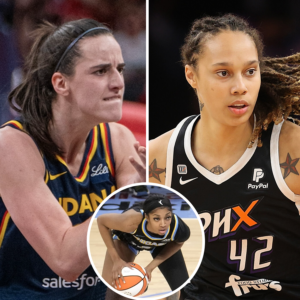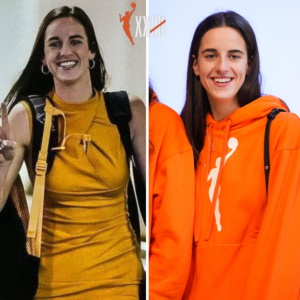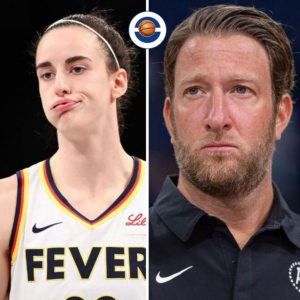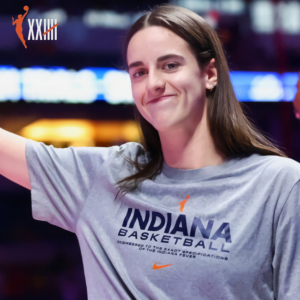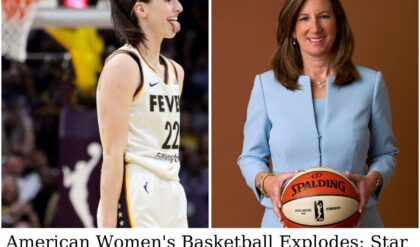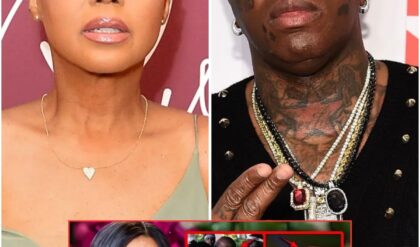/cdn.vox-cdn.com/uploads/chorus_image/image/73394056/CaitlinClarkDiscourse_Getty_Ringer.0.jpg)
It was the body check heard around the world. By now, you know about it. On Saturday afternoon, in Caitlin Clark and Angel Reese’s highly anticipated first WNBA clash, Chicago Sky guard Chennedy Carter blindsided Clark while she waited for an inbounds pass, shoulder-checking her and calling her a “bitch” as she tumbled to the floor. Carter, who was assessed a common foul, was retroactively given a flagrant foul by the WNBA the next day. She refused to answer questions about the incident after the game, instead taking to Twitter and even Threads to call Clark one-dimensional.
Two days after the game, Sky coach Teresa Weatherspoon released a statement, calling Carter’s play “not appropriate.” It didn’t even rank among the top 10 most dramatic public reverberations from the incident. Complaints about Clark being physically targeted, alongside speculation that her peers held her in jealous contempt, had been percolating all season. But Carter’s foul brought them to a fever (sorry) pitch. In the days since, the incident has dominated sports media. Even Billie Jean King, Geno Auriemma, and Nancy Lieberman have weighed in.
Clark’s first 11 games, played in a dizzying, exhausting 20 days, have featured two wins, nine losses, multiple uncomfortable reckonings, and a media shitstorm of outrage. Here are 12 thoughts on Clark and the WNBA as she heads into her 12th game on Friday.
1. Caitlin Clark has become the oracle through which everyone else litigates their favorite causes. Every Clark controversy has an extended shelf life because it prompts questions and coverage that transcends the normal bounds of sports media. When she plays (and especially when she plays Reese, as she did for the 2023 national title and this year’s Elite Eight), the coverage of women’s basketball suffers from the unfortunate combination of being under a powerful microscope and being scrutinized by new fans and media members (including myself) who lack historical context of the league and its players.
As Reese put it on Tuesday, in a defense of her teammate that doubled as the forging of a team identity, “You gotta realize all of us have a story,” she said. “Chennedy has been out of the league. I’ve had a story behind me. People are gonna have their misconceptions about everyone on this team. That’s what makes it so special. I wear that on my shoulders. Chennedy wears this on her shoulders, because everybody doesn’t get this opportunity, so when we go out there and play super hard, compete every single day, it’s not personal. I promise you, it’s based off our stories and where we’ve come from. We’ve come from so many different places that you guys have never seen and will never understand.”
But for new fans who are only interested in Clark, all roads and all motives must lead back to her. Throw a bevy of unanswerable questions into platforms designed to incite rage, and you’ve got all the ingredients for a media circus. Was Clark flopping against the Sky? Did she invite Carter’s foul by talking trash? Why didn’t the refs call a flagrant on the spot? Why didn’t her teammates have her back? Is the WNBA really that physical, or are her jealousy-driven peers simply out to get her? Or is that mere suggestion a misogynist projection onto the unknowable motives of hyper-competitive athletes? These questions are also a proxy for the topics that really spur debates about women’s sports into the political stratosphere: race, gender, white privilege, modern womanhood.
In our modern hot take industrial complex, there’s nothing as delicious as a controversy that offers up this many entry points, rabbit holes, points and counterpoints, misinformation and rushed attempts to clear it up. Social media, in the past few days, has been cluttered with ragebait, alongside videos of Candace Parker, Aliyah Boston, and Angel Reese enduring similar rookie treatment, alongside arguments that each incident, for some particular reason, is different from Clark. There’s a circular myopia to all of this, the way discoursebait begets ragebait begets dunkbait in a self-sustaining, exhausting, and begrudgingly addictive manner, like so much of the brain rot of our current moment.
2. Caitlin Clark is David, and the WNBA is her new Goliath. Clark has been relatively impressive, leading all rookies in points and tying for the second-best assist average for any WNBA rookie in history. She also leads the league in turnovers by a wide margin. She’s shooting just 35.7 percent from the field and the Fever offense (third worst in the WNBA) has fallen way short of the aesthetically pleasing, high-octane stylings of her Hawkeyes.
Clark was an omnipotent, all-seeing force at Iowa, dominant enough to determine the context of the game. Now she has to seek out advantages presented by her opponents, who play with—as we know—a level of physicality she has never seen before. The refs are swallowing their whistles and the vets are ruthlessly unforgiving to their young prey. There’s no hand-holding. It’s survival of the fittest. Clark has taken it mostly in stride, even if the world hasn’t. While she, her coach, and the Fever’s general manager have expressed dismay at how few calls she’s getting, Clark has also told reporters that none of the physicality has come as a surprise.
At Iowa, the system magnified her strengths and hid her flaws. The WNBA has laid them all bare. She’s realizing it, going from joking that hopefully her offense will make up for her defense, to understanding that offense isn’t going to come easily without defense, and redoubling her efforts on that end. Her first WNBA bucket, after all, was a transition layup.
It’s also why she’s so apt to run headlong into screens.
Progress is rarely pretty, even if its spoils are. Clark, coming off a long college season and an unprecedented press tour, told reporters recently that she’s talked to the media more than her family in the past month. The room laughed. “It’s not a joke,” she interjected. “It’s sad.” As she gets acclimated and hits the weight room, she’ll get an opportunity to respond with her patented lightning-fast, long-range shooting. Already, opponents like Victoria Vivians have reignited the brash, defiant “fuck you” heelery that drew fans to Clark in her early college days. It was, in fact, the origin of her conflict with Carter, who is cut from what has historically been a more destructive version of that same cloth: a trash-talking back-and-forth that Carter escalated into a cheap shot. Clark’s temper has also boiled over against opponents and referees at times early this season. Frustration, for most of Clark’s career, has been a springboard for progress.
In the meantime, it’s been fascinating to watch someone with her scope of ambitions, whose skill has always allowed her to play with an expansive sense of imagination, take a step back and hone the building blocks of her game: her defense, midrange game, strength, and penchant for turnovers. Clark projected rarefied confidence at Iowa. In her first preseason, the Fever sent her film of her off-ball impact to remind her she had value outside the box score. Clark, who has likened this experience to her freshman year, will have to reconstruct her game before she can dominate on the most competitive stage in women’s basketball. Her early struggles have all the makings of a great comeback story, but it’s going to be a slow burn.
3. The Fever are bad, and the ratings are bearing it out. While Sky-Fever averaged 1.53 million viewers, viewership for the Fever’s first seven games successively dropped, from a season-high 2.1 million in Clark’s debut to 333,000 on May 25 against the Aces (though that game was on NBA TV).
Some of this is natural. Like most teams that secure back-to-back no. 1 picks, the Fever are a hard watch. They have the WNBA’s worst net rating. Intrigue, through the course of a long professional season, waxes and wanes. The tsunami-like momentum of Clark’s senior year at Iowa, where the momentum behind her breaking the all-time scoring record flowed seamlessly into the Big Ten tournament into March Madness, was never going to be replicable, which brings me to my next point.
4. The worst thing the WNBA could do right now is make things easier on Clark. The mere suggestion, antithetical to the nature of sports, would undercut the very thing that made Clark’s rise in Iowa so potent: its authenticity. Clark herself has cited her freshman year in Iowa as a good comparison point for what she’s going through now, and her early numbers—matched historically only by Sabrina Ionescu—suggest she is headed toward greatness. But that process shouldn’t be fast-tracked. If her command of the game—and the momentum it created—has to be stalled for a few years, then so be it. If she’s the real thing, she’ll figure it out, and the spoils will be all the more rewarding. Like any other great player, it’s Clark’s job to meet the physicality and skill of the competition.
5. Or would it be the best thing? Stars meet the moment. And sometimes, the moment bends to meet stars. The NBA, in particular, has never shied away from altering its rules to make it harder to defend stars. An under-reported plotline to the 1990-91 NBA season, when Michael Jordan finally solved the “Jordan Rules” and overcame the Bad Boys Pistons? The summer before the season started, the NBA’s rules committee upped the penalty for committing a flagrant to two free throws and possession of the basketball, adding that defenders could be ejected if referees determined they weren’t making a play on the ball. Detroit’s players couldn’t just maul Jordan anymore and get away with it. To the credit of Jordan and the Bulls, they also upped their physicality and added reinforcements (speaking of which, Angel McCoughtry is volunteering to be an enforcer for the Fever), but the league certainly helped them along. In the early 2000s, banning hand checking led to a scoring inflation the NBA is finally having to reckon with, after two decades of enjoying the spoils of fancy, crowd-pleasing perimeter play.
6. The WNBA, sitting at the nexus of Blackness, queerness, female masculinity, and physicality, is making a chunk of its new audience uncomfortable. The editorial board of The Chicago Tribune, for example, the Sky’s hometown paper, took her to task, with the logically dubious reasoning that what Carter did would be considered assault off the court. A congressman from Indiana has even weighed in, sending a letter to the WNBA commissioner about the foul on Clark, asking what the league would be doing to “curb excessive physical targeting of specific players.”
While Carter’s foul was certainly a cheap shot and out of the bounds of normal basketball play, deserving of a technical, anyone who has ever participated in a contact sport understands the rules are different within the lines. The fact that professional football sanctions aggression is, in fact, part of what makes it so appealing. It’s a part of the game that NBA fans are nostalgic for.
But female athletes displaying physicality, traditionally associated with masculinity, makes people uncomfortable. Historically, women’s sports leagues—from the All-American Girls Professional Baseball League to the WBL, the first women’s professional basketball league, to the WNBA itself—have tried to counterbalance it by imposing feminine dress codes on its players, mandating lessons on makeup application, and putting out messaging insisting that women’s participation in sports wouldn’t threaten the order of the traditional, heteronormative nuclear family. Those days, obviously, are long gone. In recent years, via self-presentation and on-court style, WNBA players have pushed further against gender norms.
But visibility, for the marginalized, can be harmful. For example, Carter, in the days since pushing Clark, has been disparagingly called a thug and a man. When the Sky arrived at their hotel in Washington on Wednesday night, a man confronted the team, according to the Chicago Sun-Times, targeting Carter in particular. Many of these players have gone from competing and interfacing within a smaller, safer niche, to being catapulted into a mainstream sports audience that derides their very existence. Clark has brought more eyes to the WNBA, but some are carrying a heavier burden of unwelcome attention than others.
7. Is the controversy just going to bring more eyeballs to the WNBA? The Fever-Sky rivalry, and the controversy it created, couldn’t have come at a better time, breathing intrigue back into a Fever season that was losing its luster and spotlighting two of the biggest stars in the league.
In a stroke of scheduling serendipity, the Fever and the Sky will play two more times in June. I know I’ll be watching. I also, as it happens, couldn’t help but tune into the Sky’s last game against the Liberty. The first half was the Chennedy Carter show. The early Sixth Woman of the Year contender came off the bench to the tune of raucous applause and scored 15 first-half points.
She went 0-for-7 in the second half, though, and in the fourth quarter, the Liberty out-executed the Sky and Reese was ejected after telling the ref a foul was “bullshit.” Even her opponent, Liberty star Sabrina Ionescu, was confused. Lonzo Ball, who was in attendance, offered to pay Reese’s fine before the WNBA rescinded the second technical the next day. In the meantime, it’s prompted another news cycle: Does Reese need to reel it in, or do the refs? Would Clark, similarly foul-mouthed, ever be ejected for swearing? The discourse machine keeps turning its wheels.
8. Basketball players don’t have to like each other. We often lament how NBA players are too close off the floor. Why should the WNBA be different? I had no problem with Reese jumping out of her seat to celebrate Carter pummelling Clark. The duo has knocked each other out of the NCAA tournament in back-to-back years. It would be strange if there weren’t any hard feelings. It wasn’t until 1987, on the set of a Converse commercial, that Magic and Larry finally buried the axe. Their animosity made the Lakers-Celtics rivalry all the more compelling. Carter and Clark have the opportunity to do that for Sky-Fever, a matchup that already features history between marquee players, proximity, and a styles-make-fights contrast. They may as well lean in.
9. Angel Reese is really good at being famous. Two weeks ago, after Alyssa Thomas was ejected for clotheslining Reese, Reese addressed a question about the physicality rookies were facing by denying its premise.
“It’s not just because I’m a rookie,” she said. “I’m a basketball player. They don’t give a damn if I’m a rookie. I want them to come at me every day. I want them to come at everybody. They’re not supposed to be nice to me. I hope y’all know that. They’re not supposed to be nice to me or lay down because I’m Angel Reese or because I’m a rookie.”
The answer, which circulated even further after fans compared and contrasted it to Carter’s foul on Clark, worked against the narrative that this year’s rookies were getting particularly harsh treatment, and positioned her as a tough, no-excuses player.
It’s also why Reese not speaking after the Fever game, which prompted a fine and a press release from the WNBA, was a mistake. The next day, when she did address reporters, she said it was a miscommunication that wouldn’t happen again, and talked about her willingness to take on the role of the bad guy for the sake of the growth of the sport, which she cited as not being just because of “one person.”
Reese understands how to dismiss and enrage her critics in just one sound bite. She knows she will be misunderstood, so she doesn’t bother explaining herself. Being a mainstream villain makes her a profitable counter-cultural hero. For every talk radio type that lambasts her lack of humility, there’s a young TikToker excitedly typing, “Angel Reese they could never make me hate you Angel Reese!!!,” while celebrating her confidence. Confidence is something she shares with Clark, and the higher degree of pushback she gets makes her all the more defiant. So she collects barbs from Fox News and OutKick while collecting checks from Reebok and Mielle, while gracing the cover of Women’s Health and announcing her foray into the WNBA via Vogue. She understands, like the WNBA has in recent years, that the league and its players have a unique opportunity to tap into demographics that will embrace rather than reject their identities.
Reese represents a perceived need to see a Black woman who is at one moment unflinching in the face of the world’s cruelty and in another, willing to show that she does indeed get hurt by what her critics say. She is someone who embraces her status as a villain but approaches it with something more vulnerable than the “You know why I’m here” stiff upper lip and Draymond-esque bravado we’re accustomed to in men’s sports.
Reese hasn’t drawn eyeballs to the game with the same chart-topping proficiency as Clark. Aesthetically, that makes sense: one shoots 30-footers, the other leads the WNBA in offensive rebounds. But Reese’s persona and social media savvy give her plenty of off-court appeal. She’s a lightning rod for conversation, who still has more followers on social media than Clark. They are, on and off the court, fascinating foils.
10. Accusations of bitterness have become the WNBA’s scarlet letter. It’s a variation on the “angry Black woman” trope, levied against the league’s old guard to disregard their opinions out of hand. Was Diana Taurasi just being honest (in a prediction that’s now been vindicated) when she said in April that “reality is coming” for Caitlin Clark? Nope. She’s jealous she didn’t get the same attention and praise.
Was Breanna Stewart (another GOAT candidate) simply stating her opinion when she said you need a title to be the GOAT of college basketball? Nope, just a jealous old head scared that Clark is coming for her spot.
Could Becky Hammon simply have been adding context to the forces behind the growth of the league when she said “women’s basketball has been at this boiling point.” Nope, just a resentful woman who’s trying to discredit Clark’s singular impact.
The reality is, multiple things can be true at once. Clark has a magnetic personality and box office style that has brought unprecedented attention to the game. The league was also setting the foundation for the arrival of a star like Clark for years.
The general public’s unwillingness to hold both of these thoughts in mind at once would naturally create resentment in older players, though I imagine that’s the goal for some people. And the truth is, in a league with 144 roster spots, some people are going to be jealous. I just don’t understand why that has to be something we hold in such contempt.
We like our elders to be magnanimous purveyors of wisdom, encouragement, and gratitude. And hey, why wouldn’t we? Those are good things, but they don’t take into full account how it feels to endure the long layovers and commercial flights and low pay and little recognition, and watch the spoils you sacrificed for be bestowed on someone else. Bitterness isn’t the most becoming, nor productive emotion, but it is human. Who wouldn’t be a little jealous? It’s possible for veterans to enjoy watching young players thrive while simultaneously mourning the opportunities they didn’t get themselves.
11. Of all the people who could repurpose the word “bitch” into a positive term, I didn’t have Pat McAfee on my bingo card.
12. Is Pistol Pete the best corollary for Clark right now? The dazzling plays, the record-breaking individual seasons, the commercial omnipotence, the unprecedented anticipation, the perceived white savior of a majority Black league, the offers to play for multiple leagues, the signs of burnout, and, well, the reality check when they transitioned from college to the pros.
Waiting for Pistol Pete, after he signed the biggest contract in professional sports history as a rookie back in 1970, were players who were bigger, stronger, more experienced, and less acclaimed.
For as much hype as Pete Maravich generated coming out of college, there was always doubt about whether he would translate to the NBA. He was the third pick, not the first, and he was burdened by his father’s pressure and struggled with substance abuse by the time he was Clark’s age. This isn’t a direct comp, but the early parallels between him and Clark are a reminder that patience is key.
News
BREAKING: Kate Martin sparked controversy on social media when she demanded that the WNBA organizing committee review the VAR and ban Angel Reese from playing for her unsportsmanlike act of punching Caitlin Clark in the head. “We must eliminate the dirty elements to make the game cleaner.”
Kate Martin has sparked a social media uproar by publicly calling on the WNBA organizing committee to review the incident using VAR and to ban Angel Reese from playing. This demand stems from Reese’s unsportsmanlike conduct, where she was seen…
Brittney Griner asked Angel Reese instead of Caitlin Clark to compete in the 3×3 Olympics after Cameron Brink suffered an injury. I think “Angel Reese is better than Caitlin Clark”, causing fans to argue fiercely on social media.
In a surprising turn of events, WNBA star Brittney Griner has chosen Angel Reese to compete in the 3×3 Olympics, following an injury to Cameron Brink. Griner’s decision, and her accompanying statement that “Angel Reese is better than Caitlin Clark,”…
Caitlin Clark’s GPA Has Been Revealed In The Wake Of Her WNBA Debut, And It Will Shock You
Caitlin Clark (Photo via @caitlinclark22/Instagram) Caitlin Clark was bossing college both on the court and in the classroom. The new Indiana Fever guard left the NCAA as its highest-ever scorer and has already put on a show in the WNBA, having made her professional…
David Portnoy Slams Team USA for Excluding Caitlin Clark from Olympic Roster, Citing Missed Opportunity for Women’s Basketball
You can love Caitlin Clark. You can hate Caitlin Clark. You can love her Iowa roots. You can hate her Iowa roots. You can like her because she’s white or dislike her because she’s white. The same goes for being…
Indiana Fever Rookie Caitlin Clark Causes A Massive Stir With Her Unusual Social Media Activity
Caitlin Clark (Photo by Maddie Meyer/Getty Images)© Provided by Total Pro Sports Caitlin Clark made a curious move on social media this week, liking a certain post. The Indiana Fever point guard has made it a point to let folks know…
OUT OF BOUNDS: David Portnoy – El Presidente harshly criticizes Team USA for leaving WNBA rookie sensation Caitlin Clark off its Olympic roster. The Barstool Sports founder argues that the league missed a golden opportunity to grow women’s basketball.
Barstool Sports founder David Portnoy, better known online as “El Presidente,” is throwing shade at the selection committee behind the USA Women’s Olympic Basketball team. The controversy? The omission of WNBA rookie phenom Caitlin Clark from the roster. Clark, a…
End of content
No more pages to load

